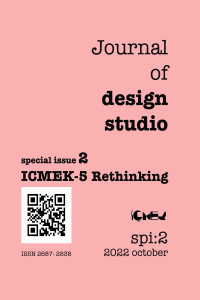Exploring Media Architecture Design in Virtual Design Environments
Exploring Media Architecture Design in Virtual Design Environments
This case study explores how architecture students can learn to design media architecture within vir-tual design environments tools. The target participants of this study are advanced (i.e. 3rd year) archi-tecture students at the University of Applied Science, Bochum, Germany. To evaluate the student-experience, students were asked to develop a media architecture structure during the semester. Once the project finished the students provided feedback via surveys and interviews. The feedback was analysed employing thematic analysis. The case study shows that students are curious about technol-ogy in the design process and that technology has a growing relevance in an architecture career. The feedback will be used to improve future teaching approach.
Keywords:
Design education, Design studio, Immersive design environment, Media architecture, Virtual reality,
___
- Braun, V., & Clarke, V. (2013). Successful qualitative research: A practical guide for beginners. SAGE.
- Brynskov, M., Dalsgaard, P., & Halskov, K. (2015). Media Architecture: Engaging Urban Experiences in Public Space. In J. Lossau & Q. Stevens (Eds.), The Uses of Art in Public Space (pp. 51–66). http://site.ebrary.com/id/10994059
- Burdick, A., & Willis, H. (2011). Digital learning, digital scholarship and design thinking. Design Studies, 32(6), 546–556. https://doi.org/10.1016/j.destud.2011.07.005
- Epic Games. (2020, November 13). Twinmotioin. Twinmotion. https://www.unrealengine.com/en-US/twinmotion
- Gonavaram Bala Sai, S. S. (2004). Interactive teaching model: A proposal to integrate basic architectural design pedagogy with digital media [M.S., University of Missouri - Columbia]. http://search.proquest.com/docview/305162912/abstract/9DAE3AE8C951488BPQ/13
- Graphisoft. (2020, November 13). Archicad. Archicad. https://graphisoft.com/
- Gross, M., & Do, E. (1999). Integrating digital media in design studio: Six paradigms. Proceedings of the American College Schools of Architecture Conference, Minneapolis, gub.
- Guney, D. (2015). The Importance of Computer-aided Courses in Architectural Education. Procedia - Social and Behavioral Sciences, 176, 757–765. https://doi.org/10.1016/j.sbspro.2015.01.537
- Haeusler, M. H., Tomitsch, M., Tscherteu, G., & Berkel, B. van. (2012). New media facades: A global survey. Avedition.
- Keller, J. M. (2010). Motivational Design for Learning and Performance. Springer US. https://doi.org/10.1007/978-1-4419-1250-3
- Kuhn, S. (2001). Learning from the architecture studio: Implications for project-based pedagogy. International Journal of Engineering Education.
- Mathews, J. M. (2010). Using a Studio-Based Pedagogy to Engage Students in the Design of Mobile-Based Media. English Teaching: Practice and Critique, 9(1), 87–102.
- Obeid, S. (2019). The influence of virtual reality on design process creativity in basic design education [PhD Thesis]. Bilkent University.
- Salman, H., Laing, R., & Conniff, A. (2008). The Changing Role of CAAD in the Architectural Design Studio. The Built and Human Environment Review, 1, 25.
- Wei, X., Weng, D., Liu, Y., & Wang, Y. (2015). Teaching based on augmented reality for a technical creative design course. Computers & Education, 81, 221–234. https://doi.org/10.1016/j.compedu.2014.10.017
- Yayın Aralığı: Yılda 2 Sayı
- Başlangıç: 2019
- Yayıncı: Orhan HACIHASANOĞLU
Sayıdaki Diğer Makaleler
Esin KÖMEZ DAĞLIOĞLU, Ekin PINAR, İpek GÜRSEL DİNO, Pelin YONCACİ ARSLAN, Funda BAŞ BÜTÜNER
Exploring Media Architecture Design in Virtual Design Environments
Waldemar JENEK, Glenda CALDWELL, Jared DONOVAN, Veronica GARCİA HANSEN, Matt ADCOCK, Mingze XI
Lacunae in the Forest: A Phenomenological Approach in the Interior Design Studio
The Threshold of Abstraction in Beginning Design Pedagogy
Integration of Section and Model: Reflections from a Studio Practice
Bridges as City Landmarks; A Critical Review on Iconic Structures
From Movie to Design: Interpretation of “Passengers” in the Form of Basic Design Principles
Orkan Zeynel GÜZELCİ, Sema ALAÇAM, Serkan KOCABAY, Elif AKKUYU
